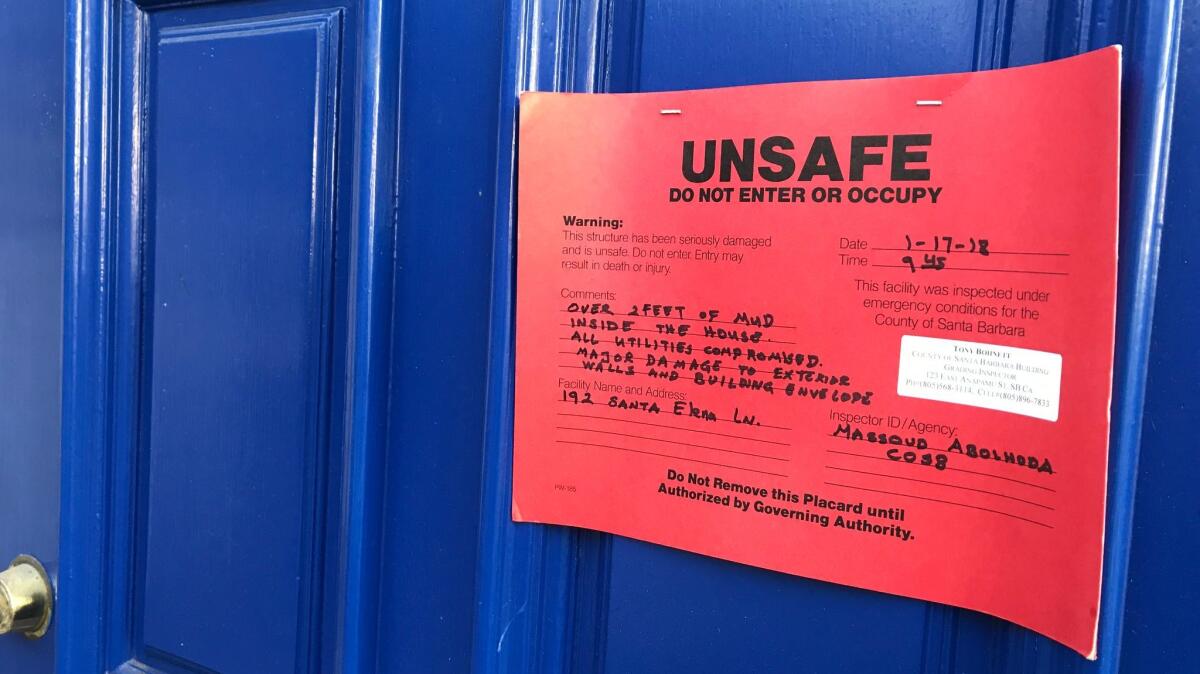Column: Two weeks later, Montecito’s devastated neighborhoods are still empty and eerily quiet

- Share via
Reporting from Montecito, Calif. — On Sunday, Montecito’s neighborhoods were mostly deserted. I walked along muddy streets, awed by the devastation.
Squishy muck covered lawns and driveways. Backyards were boulder fields. Front doors were flung off their jambs, revealing mud-filled living rooms, storm-tossed couches and other personal effects strewn inside and out. Some homes were buckled by the deadly combination of fast-moving mud, boulders and tree trunks. Cars were parked at awkward angles.
The smell of wet earth, musty and thick, hung in the air, a tangible reminder of tragedy in the same way that the smell of smoke was a signature of the Thomas fire, which paved the way for Montecito’s disaster, and may be responsible for floods yet to come in other vulnerable burn areas, like Carpinteria and Ojai.
It was dead quiet, except for the cawing of crows poking around piles of fast-food wrappers left by work crews.
::
For the first time since the debris flow, Highway 101 in Montecito opened Sunday to traffic.
All the Montecito off-ramps were closed, though, so I pulled off the 101 north at Salinas Street and doubled back along Old Coast Highway toward Montecito Village, which serves an upscale community of about 9,000. Nothing was open. The charming commercial district, with its hotels, cafes and expensive boutiques, looked intact, but remains under evacuation orders.
By the time I got to Santo Tomas Lane, a residential street a few blocks east of Montecito Village, so much cleanup had already taken place it was hard to imagine how it must have looked just after the deadly debris flow coursed through before dawn on Jan. 9.
I assumed I’d find some homeowners, perhaps searching for valuables, or assessing their property damage, figuring out how to rebuild and recover. But the neighborhood was empty, and it’s unclear when people will be allowed to return.
Heavy trucks kicked up mud as they rumbled down streets. Scattered work crews from Caltrans and various utilities were busy working to restore gas, power and water to the lovely but battered town. I saw a few U.S. Army Corps of Engineers vehicles.
Only work crews and reporters were allowed into the evacuation area. Even after passing through several checkpoints, I must have been stopped and asked for my press credential another five times. It may be small comfort to those displaced by this disaster, but their homes, some of which appear completely intact, and possessions are being zealously protected.
It’s not as if Montecito is entirely in the clear. The town may still be vulnerable to flash flooding, said Tom Fayram, a deputy director in the Santa Barbara County Public Works department, particularly if another heavy rain comes before storm drains are unclogged.
Even if it does, it is unlikely to deliver the kind of destruction that happened Jan. 9, when massive boulders, some 15 to 20 feet around, bounced along a river of mud and rock at speeds of up to 30 mph, taking out everything in their path.
“It’s not like a stream with boulders moving along the bottom,” said UC Santa Barbara geologist Ed Keller, who studies the relationship between wildfire and debris flow. “The big rocks are on top, bouncing like pingpong balls on mud that is like molasses, 200 times as viscous as water. It almost floats them.
“Montecito means ‘little hills,’” he added, “with rocks all over the place. Everyone loves those rocks, but no one ever asks where they came from.”
The geologist, with the long view that is the soul of his profession, will be happy to tell you exactly where they come from. Even if his explanation is not very reassuring.
“All of Montecito is built on old debris flows,” Keller said. “They date back to 125,000 years. So is Santa Barbara for that matter. And the linkage between fire and debris flow is really well known.”
::
On Saturday, cadaver dogs discovered the body of Faviola Benitez Calderon, a 28-year-old mother of two who had been missing for two weeks. She became the fourth member of her family to die — her 10-year-old son, sister-in-law and 3-year-old niece also died — and the 21st victim of the flood. Two people are still missing.
It had taken two weeks to remove 105,000 cubic yards of debris — mud, rocks and trees — from the quarter-mile stretch of the 101 that signals the transition between arid Southern California and our more bucolic Central Coast.
Apart from a bright green film of hydroseed along the median and shoulders — a sprayed-on ground cover designed to quickly sprout vegetation and stabilize the turf, said a Caltrans spokesman — the freeway looked absolutely normal, far more than you can say for parts of Montecito, which will spend years recovering from this blow.
At dusk, as I was leaving to drive back to Los Angeles, three television news vans pulled into Montecito Village. They would use the 101, now flowing with cars, as a backdrop for their 6 p.m. flood updates.
Finally, for a change, they had some good news to report.

Twitter: @AbcarianLAT
More to Read
Sign up for Essential California
The most important California stories and recommendations in your inbox every morning.
You may occasionally receive promotional content from the Los Angeles Times.














